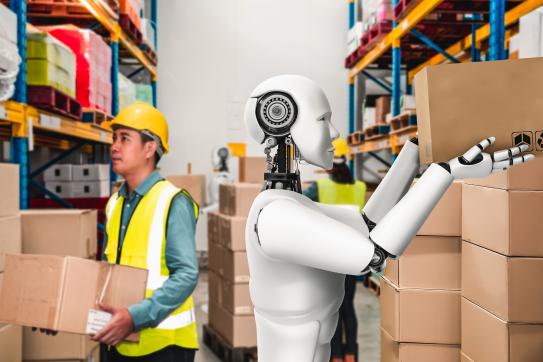ChatGPT made its splashy debut at the end of 2022, its capabilities both astonishing and unsettling users around the globe. But even as people continue to grapple with the new technology, Miklos Sarvary and Bernd Schmitt are already preparing for how people will engage with the next iterations of artificial intelligence (AI).
Sarvary, the Carson Family Professor of Business in the Marketing Division at Columbia Business School, has been working closely with Schmitt, the Robert D. Calkins Professor of International Business in the Marketing Division at CBS, and co-author Noah Castelo, assistant professor at the University of Alberta’s School of Business, to examine how people feel about engaging with humanlike robots. Their most recent research explores people’s attitudes toward robots — from a small assistant called Jibo to the humanlike android Nadine — raising a series of questions, from “Do people like working with robots or not?” to “What increases or decreases comfort with robots?” Their findings suggest major implications for companies hoping to successfully integrate robots, chatbots, and other AI labor, says Sarvary.
Robots Can Make People Uncomfortable
Sarvary and Castelo’s study, Cross-Cultural Differences in Comfort With Humanlike Robots, finds a strong dislike of robots when they replicate human interactions too closely, particularly in the United States. It expands on earlier research Sarvary and Castelo conducted with Schmitt in their paper Human or Robot? Consumer Responses to Radical Cognitive Enhancement Products.
“Surprisingly, we found that there is a deep aversion to robots — we call this speciesism,” Sarvary says. “A perfect robot that cannot be distinguished from humans makes people feel stressed, and they will deny it any kind of humanity.”
Interestingly, Sarvary found significant differences between how American and Japanese workers responded to humanlike robots. The Japanese workers reported greater comfort with robots that looked human than Americans did. One possible explanation for this difference? Western religious and philosophical tradition accords humans a unique and privileged position in relation to God and the universe. Japanese culture, particularly as expressed in the Shinto religion’s emphasis on animism, does not. The new study points to popular culture as one area where this contrast can readily be seen: Astro Boy, Japan’s most popular fictional robot, feels emotion and fights crime; in contrast, American narratives more typically portray AI and robots as threats to humanity, from 2001: A Space Odyssey to The Matrix and beyond.
The research by Sarvary, Schmitt, and Castelo comes at a time of both rapid growth and renewed debate regarding the pace of advances in technology such as AI. The long-standing concern about robots leading to job loss has grown as AI recently demonstrated aptitude in professions ranging from journalism to law to graphic design. And recently, top computer scientists and technology leaders, including Elon Musk and Apple co-founder Steve Wozniak, called on the industry to pause the training of AI systems for six months due to concerns that their creators may not fully “understand, predict, or reliably control” the “digital minds” that are developing.
Getting Workers On Board
This latest research indicates that increasing workers’ comfort level will be key to successfully integrating AI, leading to benefits as humans manage and collaborate with robots. To move toward that outcome, companies should be transparent about when these technologies are being employed and make the technology less humanlike, particularly in an American workplace. This could help alleviate some of the “speciesism” that leads to worker discomfort — or even resentment and distrust.
Yet, regardless of how employees feel about their robot-assistants, companies will continue to feel pressure to keep pace with new technologies. “There is no real choice,” Sarvary says. “If a firm doesn’t adopt the state-of-the-art technology, it’s going to be left behind in the competitive domain.” Companies are grappling with issues such as how to upgrade a workforce by choosing when to bring in AI for a strategic advantage and how to train people to work effectively with AI and robots.
Sarvary suggests taking comfort from historical examples about how society adapted to new technologies. He points to the advent of the Industrial Revolution, which initially sparked societal revolt, most notably among the Luddites of the textile mills. “When machines appeared, workers destroyed the machines,” Sarvary says, but eventually workers adapted, and the change ushered in workplace reforms helping remove child labor from the factory floors. “While it is a classical example, today we are experiencing something similar.”
“In the long run, new technologies have created jobs and made humans more productive,” Sarvary says, and he foresees that AI and robots will be no different. But by recognizing and adapting to culturally based resistance, companies can make the transition to a robot-enhanced world more comfortable for everyone.
For more on this topic, watch our interview with Professor Hod Lipson, director of Columbia University’s Creative Machines Lab, who discusses the current state of AI, robotics and what the next waves of innovation could bring:
